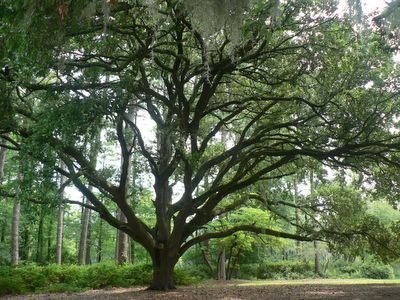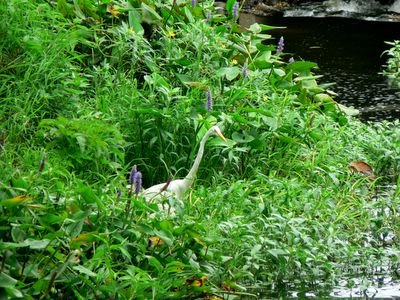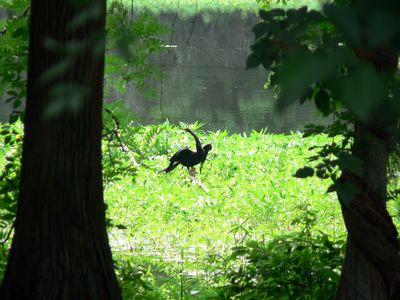Anyway, I will try to be a little better this week. Of course, I have training on Tuesday - won't be home until after midnight, I'll be deep in the work swamp on Wednesday attempting to locate some damaged trees that were spotted during a flyover by forestry, Thursday I'll be in a workshop, and Friday I have meetings all day...and y'all thought all I did was run around taking pictures :)
To tide you over, I have posted three pictures taken down in Wilmington, NC. Treebeard and I went there last weekend to visit Son 1. (The cat in the previous post belongs to our son, so I guess you could say she is my grandcat. Her name is Izzy and she is awesome! Yes, FC, there is such a thing as a great cat -- and don't worry, she is strictly indoors.) The pictures were taken at Greenfield Lake, a city park with a four mile trail that follows along the shoreline of the little lake.

Live oak, Quercus virginiana
Wouldn't it be great to grab a book, climb up into those branches and read for a few hours. Live oaks are one of my favorite trees.

Great egret, Ardea alba
If I had pulled out just a bit, you would have seen the very busy street that runs by this spot. The noise and movement didn't seem to bother this egret though. It just concentrated on hunting up some lunch.

Anhinga, Anhinga anhinga
We watched this anhinga for a while. It is fun to watch one hunt - all you can see is the long skinny neck and head above the water, the rest of the body is submerged. They have sharp bills that they use to spear fish. Unlike most other waterfowl, anhingas have no oil glands to keep the water from soaking into their feathers so they must spread their wings to dry when they come up out of the water.
10 comments:
All are nice but I particularly love the Anhinga! I wonder if they are in decline... we used to see them all the time in south AL but the last several times we went, we didn't see any.
Rurality, I don't know about a decline. We have been seeing anhingas more frequently over the past few years up here. Treebeard saw a flock of 22 birds this spring and two years ago I saw about 15 soaring over Dismal Swamp. Prior to those sightings it was a treat to see even one in year.
That tree is awesome. I can see that one in the next Harry Potter installment. Sorry about the back pain, but glad you got to go for a visit.
Sorry about your back. I hope you're on the mend.
I have always suspected there might be great or even just good cats out there. The dogs and I are hopefully dubious.
... of course we believe you.
love the big tree
I wonder if the climate change will bring anhingas to Ontario. I would really like to see one.
May just be due to local development then. I'm glad to hear they're not in decline elsewhere!
Question: in a natural swamp, why would you care about damaged trees? Wouldn't that be expected in the natural order of things? And wouldn't a tree's decline and fall play a part in the local ecology? Just curious since I don't know much about your line of work.
Great photos! Keep them coming, I check your site at leats every other day for new pics - I'm in the city here in Baltimore.
pablo - the trees in question are near the boundary line and the adjacent property is held by private owners. The trees in question may be damaged by pine beetles and in order to maintatin good relations with our neighbors we may consider doing something if that is the case. Normally, our policy is to let things progress naturally. We feel that dead trees are a critical part of the ecosystem. Private land owners, many of whom view their trees as a financial investment, usually don't see it that way I'm afraid.
Post a Comment